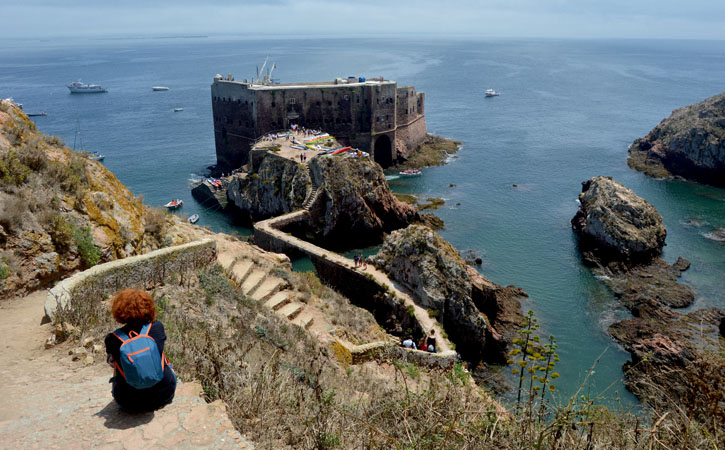1. introduction: why the Berlengas are unparalleled
Are you thinking of visiting? First of all, let me explain that the Berlengas are a group of unique islands, located about 10-15 km off the coast of Peniche, in the Western Region of Portugal.
As a result, millions of visitors are attracted by their biodiversity, dramatic landscapes and high historical value.
In addition, they are a Nature Reserve (1981), a Site of Community Importance (1997), a Bird Protection Area (1999) and since 2011 they have been part of UNESCO's World Biosphere Network.
2. What makes up the archipelago
The Berlengas mainly include three groups of islands:
-
-
-
Berlenga Grande – the only habitable one, with around 78.8 hectares;
-
Estelas – small rocky islets;
-
Farilhões–Forcados – rocks dangerous to navigation.
-
In short, only Berlenga Grande is open to the public, and the number of visitors per day is limited (up to 550 people between March and October) in order to preserve the ecosystem, and if you want to visit there is a tourist tax that is charged for each entry to the island.
-
3. Fascinating history and cultural heritage
Historically, the first records of the island date back to the 1st century BC, when it was named “Saturn's Island” by the Romans. Subsequently, it was visited by many other peoples such as Muslims, Vikings, corsairs and castaways from the most varied origins.
In 1513, monks from the Order of St. Jerome founded a monastery which, due to piracy, lack of resources and isolation, was abandoned in the 16th century.
It was in the middle of the 17th century, under the reign of King João IV (in 1651) that construction began on the Fort of São João Baptista, with the aim of protecting Peniche's coastline.
The story also goes that in 1666, the fort resisted a Spanish attack aimed at kidnapping Princess Maria Francisca.
4. Duque de Bragança Lighthouse: a guide to the region
When you get to the island, you'll notice that at its highest point stands the Berlenga Lighthouse (Duque de Bragança), a 29-meter quadrangular white tower, inaugurated in 1842 and automated in 1985.
Since 2001, the lighthouse has run entirely on solar energy and has been recognized for its good environmental practices. You can enjoy it on guided tours, open on Wednesdays between 2pm and 5pm.
5. Terrestrial biodiversity: exceptional flora and fauna
Of course, the islands have extreme conditions - wind, salinity and sun exposure - which shape adapted ecosystems, with around 100 plant species that you can observe during your walk around the island!
Secondly, as far as terrestrial fauna is concerned, unique reptiles stand out: the Carbonell's wall lizard and the ocellated lizard, found in caves.
6. Avifauna: real seabird kingdoms
Then, when you see the Berlengas, you will easily notice that it is an ornithological refuge. Among the seabirds that nest here are:
-
Seagull (Larus michahellis), com cerca de 25 000 casais;
-
Yellow-legged gull, regular visitors;
-
Shadow gull (L. fuscus), with around 30 couples;
However, endangered species such as the guillemot (Uria aalge) persist in very small numbers (around 8 individuals). For this reason, population control measures have been implemented since 1994.
7. Marine ecosystem: crystal clear waters and abundant life
In addition to its terrestrial fauna, the waters surrounding the archipelago cover more than 10 hectares of protected marine reserve and are home to around 70 species of fish such as bream, sea bream, sea bass and even grouper, as well as octopuses, starfish and anemones.
Equally important are the marine mammals, such as common dolphins, bottlenose dolphins and even pilot whales, which can be seen on tours from Peniche's port of embarkation.
8. Sustainability as a goal
As we describe in the article, the Berlengas are increasingly standing out for their strong environmental component.
Since 2001, the lighthouse and its facilities have run on solar energy. And then there are other initiatives such as “Sustainable Berlenga”, promoted by EDP and the municipality of Peniche, which aims to replace diesel with renewable energy and reinforce conservation practices.
9. Must-do activities on the island
9.1 Hiking trails
If you like hiking, there are two main trails in Berlenga Grande: one to the lighthouse, with a 360° view, and another that goes down to Carreiro do Mosteiro beach, next to the ruins of the old monastery.
During the hikes it is possible to spot birds, rock formations and viewpoints.
9.2 Snorkeling and diving
If you like adventure, diving is a memorable experience, as you can explore underground caves and reefs rich in marine biodiversity - such as in the “Parede de Rabo de Asno” or “Quebradas” areas.
There is also the possibility of snorkeling at Carreiro do Mosteiro beach or Cova do Sonho, where you can catch a glimpse of marine species.
Some companies offer kayak and stand-up paddle trips to discover caves such as the famous Blue Cave.
9.3 Whale watching
Another adventure available from the port of embarkation in Peniche and because the clear waters of the Berlengas offer excellent conditions for this, you can watch dolphins and pilot whales.
9.4 Visit the fortress and lighthouse
Our final tip is to visit the Fortress of São João Baptista, where history and magnificent views combine.
Da mesma forma, a subida ao farol, com as 265 escadas, recompensa com paisagens privilegiadas.
10. Logistics and visit planning
Transportation
The only way to get there is by boat from Peniche marina, during the official season (March to October). Normally, the trip takes around 30-45 minutes, but it can be quicker if you decide to take a speedboat (25 minutes).
As capacity is limited, we recommend booking in advance. The fact that Peniche is very close to Lisbon (around 70-90 minutes by car or bus) makes the Berlengas perfect for a weekend getaway.
Best time
Although summer is popular, spring and fall offer mild temperatures, fewer visitors and ideal conditions for birdwatching. However, be prepared for wind and protect yourself from the sun.
Accommodation
As well as sleeping in the historic fort, there is the Fishermen's Quarter - with simple houses for fishing workers - and since 2011 it has been possible to go camping, licensed by Peniche Town Hall.
11. Conservation and visiting rules
Of course, as this is a protected area, there are strict rules: keep your distance from wildlife, don't remove organisms or rocks, don't leave garbage and follow the marked trails.
Please note once again that the daily number of entries is limited to the preservation of fragile ecosystems.
Conclusion
In short, the Berlengas stand out as one of Portugal's natural treasures. With their accessible combination of history, terrestrial and marine biodiversity, outdoor activities and environmental commitment, they offer an incomparable experience.
So if you want to explore rare nature, dramatic trails, crystal-clear seascapes and bird and cetacean refuges, book a trip to Berlenga now.

